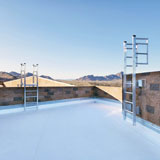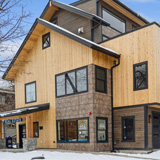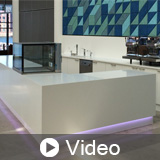Introducing a simplified approach to HVAC systems for multi-unit design projects. Join us in this one-hour course as we discuss thru the wall (TTW) HVAC units as they relate to the demand for individualized climate control in multi-unit living spaces. After this course, participants will be able to demonstrate expertise...
Saskatchewan Association of Architects
5 Upcoming Webinars
|
Mon Dec 15 - 12:00 pm EST
|
|
Tue Dec 16 - 12:00 pm EST
|
|
Thu Dec 18 - 12:00 pm EST
|
|
Thu Jan 15 - 12:00 pm EST
|
|
Tue Jan 20 - 12:00 pm EST
|
111 Online Courses
Free Course
|
|
This course covers the benefits and attributes of specialty steel door and frame assemblies. Learn benefits and attributes for acoustic, forced entry, bullet resistant, blast resistant, fire-rated, temperature rise, tornado, hurricane, lead lined, custom, wood grain, stainless steel and prefinished doors. In addition, we...
|
|
There are many factors to consider when selecting the right cast polymer shower system. Knowing the benefits and drawbacks of the types of shower systems available can help make this decision easier. From hollow-wall products, to gel-coated lightweight panels, to composite solid surface, and Class-A fire-rated products,...
|
|
In this one-hour course the history of SPF will be discussed. The physical properties of SPF insulation will be examined as well as the advantages of using SPF in the built environment. Typical applications of both open-cell and closed-cell SPF will be reviewed.
|
|
In this one-hour course, design professionals will learn about expanded metal, focusing on its manufacture, installation, and application. It will give in-depth knowledge of existing standards and manufacture tolerances as suggested by the Expanded Metal Manufacturers Association. By the end of this course, design profes...
|
|
This course covers the benefits and attributes of a variety of hollow metal steel doors and frames as they relate to the healthcare industry. Learn about the architectural design model process for these facilities and the spaces where steel doors may be required. Discover why steel doors and frames are a superior choice...
|
|
This course provides an in-depth exploration of steel doors and frames. We will cover essential door terminology and nomenclature, ensuring a strong foundational understanding. From there, we will dive into critical aspects such as fire ratings, door cores, and performance levels. In addition, we will examine frame nomen...
|
|
Gain insight into the makeup and characteristics of laminated timber columns and compare to other alternatives. Understand the importance of materials selection, production process, and testing.
|
|
Imagine discovering a treasure trove of 2,000-year-old blueprints for self-opening doors, programmable robots, and steam-powered devices. This isn't science fiction—it's the extraordinary true story of Hero of Alexandria, whose revolutionary engineering texts vanished for over a millennium before dramatically reshaping R...
|
|
Join us as we discuss the innovative uses of sustainable wood products in modern architecture, with a particular focus on versatile applications in both exterior and interior settings. In this course, participants will gain a comprehensive understanding of the benefits of utilizing abundant and sustainable wood resources...
|
|
Architectural window film that outshines expectations for energy efficiency, building safety and wellness. Join us in this one-hour course as we discuss window film as it relates to promoting a healthy space for building occupants, and how it excels in energy savings through climate control without compromising on the be...
|
|
Maximize living space and floor plan options with wall-to-wall and floor-to-ceiling custom closet doors. Join us for this one-hour course on customizable closet doors. In this course, participants will be introduced to closet doors with a myriad of possibilities in bifold and slider door configurations. With mirrored, pr...
|
|
Overlooking the smallest detail in the beginning can cause huge issues later on. Join us in this one-hour course as we cover common pitfalls designers face when specifying commercial boilers and water heaters. We will review different types of installation and application errors that can cause major safety concerns.
|
|
With the growing popularity of multi-use spaces, there is an increasing demand for fully-automated, flexible space solutions. Join us for this one-hour course as we discuss automated operable wall options in the market, end-user operation, and associated cost and time savings. By the end of this presentation, you will be...
|
|
Hot water generated with thermal efficiency in mind. Join us in this one-hour course as we discuss the sustainability initiatives and energy efficiency criteria for commercial gas water heaters and the benefits of installing a product that has met these standards. Participants will explore recent changes in building code...
|
|
This course provides a detail-oriented, full-scope plan for integrating canopy and sunshade solutions into the greater building project.The discussion emphasizes implementing best-practice methods and specification of canopy and sun control devices to gain expert function, maximum sustainability, and state-of-the-art de...
|
|
Acoustical control is a critical factor in every environment. Utilizing the appropriate operable partition to address acoustical concerns and space flexibility can simultaneously solve many problems. Join us for this one-hour course as we discuss acoustics, operable walls, and how the two together in conjunction with com...
|
|
This one-hour course examines the considerations needed during the design phase when selecting surface materials in order to help mitigate bacteria and provide easier cleanability within healthcare facilities. A deep look into microbes provides insight into the challenges and dangers of poorly selected surfaces. Various...
|
|
This one-hour course examines the use of solid surfaces to help design professionals realize the versatility this modern, sleek product now offers. Applications of trend-setting solid surfaces are explored in a variety of applications including healthcare, commercial, retail, and educational industries. A comparison of o...
|
|
On average, people use the restroom six times per day. Restrooms in a building largely reflect the design decisions you make. The purpose of this course is to make the case that a comprehensive design approach that integrates ADA design requirements, Universal Design strategies, and sustainable initiatives provides an in...
|

 (1).jpg)










































